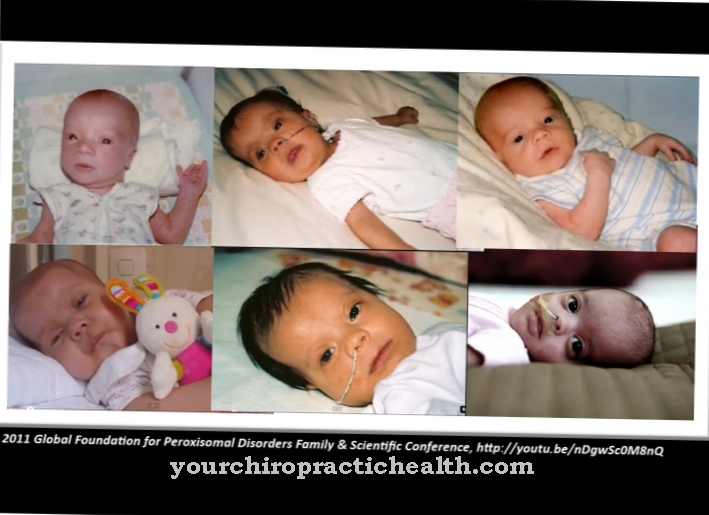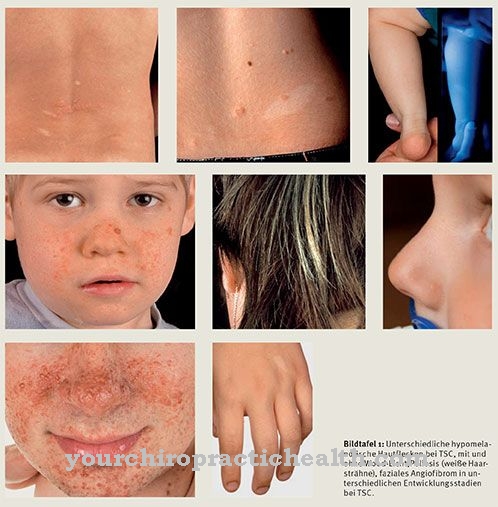From one Finger osteoarthritis or Arthrosis of the finger joint women are particularly often affected. Various treatments can help relieve symptoms.
What is finger osteoarthritis?

Finger arthrosis is a wear and tear on articular cartilage that is stronger than the wear and tear that is typical of age. On average, finger arthrosis affects ten times more women than men; Women mainly get sick during or after the menopause.
Arthrosis of the finger manifests itself, for example, in pain in the finger joints and / or in the formation of nodules that can be felt. Although finger arthrosis can have different degrees of severity, the degree of severity is not always related to the degree of discomfort:
While in some people a comparatively low degree of finger osteoarthritis leads to severe symptoms, other people hardly experience any symptoms even with severe finger osteoarthritis.
A distinction can be made between primary and secondary finger osteoarthritis; While the causes of primary osteoarthritis are often unclear, secondary osteoarthritis is a result of certain diseases or deformities.
causes
Finger arthrosis is mostly due to cartilage damage to the middle and / or end joints of the fingers. Since finger osteoarthritis occurs mainly in women before or during the menopause, a connection between primary osteoarthritis and changes in the hormonal balance (such as the decrease in female sex hormones) in those affected is suspected in medicine.
In addition, a genetic influence is assumed in primary finger osteoarthritis; Joint wear and tear in close relatives presumably increases the risk of developing osteoarthritis yourself.
Secondary finger arthrosis can be caused, for example, by gout (this is where crystals are deposited on the finger joints) or various metabolic disorders. Diseases that lead to bone changes (such as osteoporosis or bone loss) can also result in finger osteoarthritis.
Furthermore, joint misalignments (e.g. due to accidents or already congenital) can cause finger osteoarthritis. Osteoarthritis is also favored by factors such as constant joint overload or lack of exercise.
Symptoms, ailments & signs
Arthrosis in the finger joints is very painful and usually develops over many years. The disease usually begins between the ages of 40 and 50, but is hardly noticed in the first few years. The first sign of possible osteoarthritis can be the slow thickening of the finger joints.
Osteoarthritis is a progressive disease that can only be slowed down with constant therapy and applications. However, most people don't treat their osteoarthritis. The pain caused by osteoarthritis usually begins in the cold winter months. Those affected find that their fingers suddenly become less flexible and their joints often hurt. A swelling of the joints is visible. Rings should now be removed while it is still possible to prevent subsequent blood flow problems.
With the increasing severity of osteoarthritis, not only does the mobility of the finger joints decrease, but also the strength of the fingers themselves. Often, heavy loads are no longer possible, and the fingers already hurt during normal housework or kitchen work. Cutting with a knife is particularly difficult.
Finger joint arthrosis is characterized by stiffening of the joints after sleep. Although it makes sense to take it easy, light exercise and finger gymnastics can help keep the joints flexible and flexible for longer.
diagnosis
In order to diagnose finger osteoarthritis, a patient consultation usually takes place first; In this case, the attending physician asks, for example, existing symptoms (such as occasional swelling or overheating of the finger joints) and any osteoarthritis in the family.
Finger dexterity is often checked during a subsequent physical exam. Finally, x-ray examinations can reveal typical joint changes in finger osteoarthritis.
Complications
The course of finger arthrosis is usually insidious. In many cases, the onset of finger osteoarthritis does not yet lead to symptoms (in medicine this is also referred to as silent osteoarthritis) and therefore often remains undetected at first. As the disease progresses, the first symptoms can appear; when and whether this occurs varies greatly from person to person.
Untreated finger osteoarthritis leads to deformities and can lead to permanent paralysis of the fingers. First of all, there are small lumps on the front joints that do not necessarily have to be painful. Later they are permanently reddened and painful inflammations develop in all joints. The fine motor skills initially decrease and will no longer be present over time.
Every movement is associated with great pain. A relieving posture develops, the result of which is a permanent curvature. Those affected are no longer able to put their hands flat on a surface. Treating finger osteoarthritis will not completely heal the disease. But it is important to slow down the process. With the use of anti-inflammatory drugs, the pain becomes tolerable.
However, long-term use can lead to gastrointestinal problems. Pain or even ulcers are often the side effects of treated finger osteoarthritis. Those who have the knots on the joints surgically removed have slender fingers again. There is a chance that the nodes will grow again. Since the hands are very sensitive parts of the body with many tendons, the operation is not without controversy. Not every procedure is successful and individual sections of the fingers can be paralyzed.
When should you go to the doctor?
Finger arthrosis must always be treated by a doctor. Without treatment, permanent pain or paralysis can occur that can no longer be easily limited. As a rule, the doctor should be consulted if severe pain occurs after an accident or after a blow to the finger. The fingers themselves are often swollen and the pain can spread to the wrist. Wear on the joints of the fingers can also indicate finger arthrosis and should always be examined.
The fingers can only be moved to a limited extent, so that there are considerable restrictions in the patient's everyday life. If the symptoms arise after an accident, an emergency doctor can be called directly or the hospital can be visited. In the event of slight complaints, the general practitioner or an orthopedist should be consulted. In most cases, finger osteoarthritis can be treated well if treatment is started early. The disease usually progresses positively. A doctor should also be consulted at an early stage if the family is already familiar with other osteoarthritis diseases.
Doctors & therapists in your area
Treatment & Therapy
In the treatment of secondary finger osteoarthritis, an important aspect is the therapy of the corresponding underlying disease or the finger misalignment. Such therapy can also have a positive effect on finger osteoarthritis.
In most cases, however, finger osteoarthritis is primary, so that treatment of the cause is not possible here. An important therapeutic goal is therefore to combat acute pain or impairments associated with finger osteoarthritis: When the first symptoms appear, doctors often advise avoiding overexertion of the joints and heeding techniques (such as the use of grip reinforcements) that affect the joints save in everyday life.
Pain relievers or anti-inflammatory ointments / creams can be helpful against acute pain associated with finger osteoarthritis; If the active ingredients are administered using ultrasound, for example, they can penetrate deeper into the skin. For more severe symptoms of finger osteoarthritis, stimulation current treatments that promote blood circulation can be an alternative.
In the event of severe disease, surgical interventions are possible after detailed medical advice. For example, pain-conducting nerve fibers can be severed to reduce pain. If such a procedure does not make sense in the individual case, symptoms of finger osteoarthritis can also be countered with joint prostheses.
Outlook & forecast
Arthrosis in the finger joints occurs in most cases from the age of 40. This is age-related wear and tear that can only be treated to a very limited extent. The prognosis and the prospect of a complete cure are therefore not very good. The course of the disease is very much dependent on whether the person concerned receives medical and drug treatment.
If such treatment is resorted to, then the symptoms that arise can be significantly alleviated. However, a complete cure is usually no longer possible. People who suffer from osteoarthritis of the fingers usually have to live with pain in their joints. However, if you opt for treatment by a doctor, you can significantly alleviate possible symptoms and make the entire course of the disease more pleasant.
Anyone who completely refrains from such treatment must expect considerable complications. The prospect of an improvement in the general condition deteriorates significantly. In particularly severe cases, the movement of the entire hand is significantly restricted. The prognosis can only be positively influenced by early treatment by an appropriate doctor.
prevention
Primary finger osteoarthritis can be prevented to a limited extent by factors such as avoiding frequent joint overloads. In some cases, secondary osteoarthritis of the finger can be prevented by treating possible underlying diseases of osteoarthritis promptly and consistently. If there is already finger osteoarthritis, a worsening of symptoms can be counteracted by means of hand movements that are gentle on the joints.
Aftercare
With finger osteoarthritis, there are hardly any follow-up measures available to the patient. The disease must first be treated completely so that there are no further complications or other complaints. For this reason, the early diagnosis and treatment of this disease is paramount in order to avoid further complications. The earlier the finger osteoarthritis is detected, the better the further course of the disease is in most cases.
In most cases, the person affected should rest and protect their finger joints with finger osteoarthritis. Therefore, no strenuous activities should be performed with the fingers, whereby the fingers should not be unnecessarily stressed. In some cases it may also be necessary to take pain relievers, although the person concerned must be careful not to take them for a long time.
If in doubt, it is advisable to consult a doctor. If the symptoms of finger osteoarthritis persist and do not go away on their own, a new examination must be carried out by a doctor in any case. The use of ointments and creams can also alleviate the symptoms. In most cases, finger osteoarthritis does not reduce the life expectancy of the person affected.
You can do that yourself
Finger osteoarthritis is a chronic disease. Nevertheless, their symptoms can be alleviated. Particularly in the early stages, the progression of the disease can be delayed with the help of targeted hand therapy.
The focus should be on proper finger strain. Accordingly, it is not important to relieve the fingers, but instead encourage them through targeted stress. Accordingly, special exercises for hands and fingers are recommended. Those affected should therefore train explicit mobilization exercises. Accordingly, the thumb is bent down to the little finger at several intervals and then bent back up again. In this way, the saddle joint is strengthened.
In addition, an O should first be formed from the thumb and index finger. Then a 0 is formed from each finger and thumb. In addition, the fingers must be stretched like a fan and then spread apart. In addition to this mobilization - those affected can also perform gentle strengthening exercises. Accordingly, the hand can be rolled out on a mug, for example.
The fingers must be kept straight in the course of this. In addition, patients should, for example, perform kneading movements with a household sponge or a small ball. Corresponding training units should be carried out for five minutes a day.
If acute pain occurs as a result of an osteoarthritis attack, this can be alleviated with the help of cold applications. In this case, cold compresses from cottage cheese or ice packs can help relieve the pain.
A diet rich in vitamins and fibers should also be ensured. It is advisable to limit the consumption of sausage and meat products as this promotes inflammatory processes in the body. In addition, vegetable oils containing omega-3, such as virgin hemp or linseed oil, should be consumed. These contain a high proportion of this highly anti-inflammatory fatty acid.













.jpg)

.jpg)
.jpg)











.jpg)